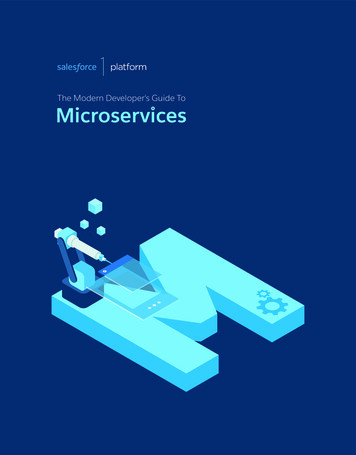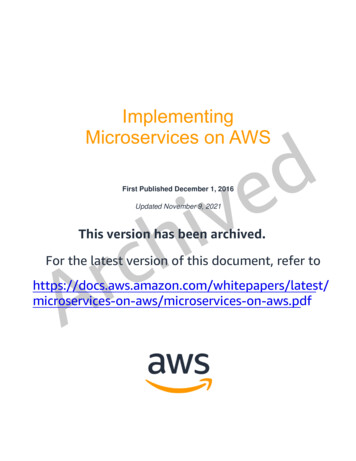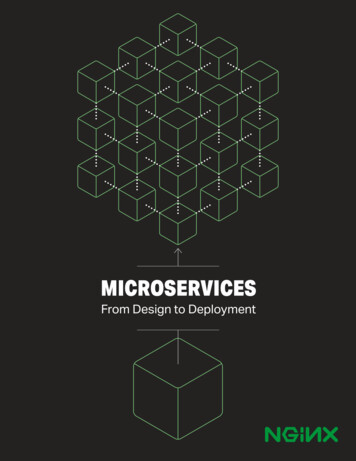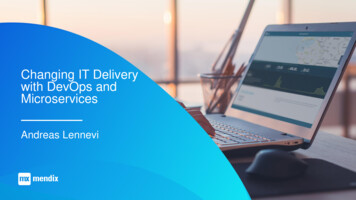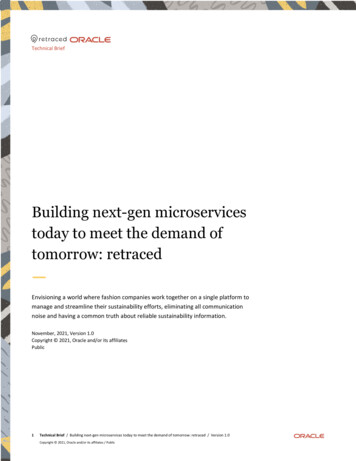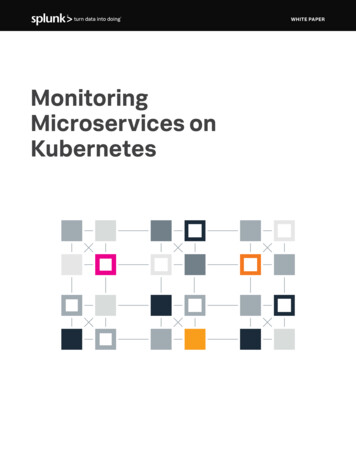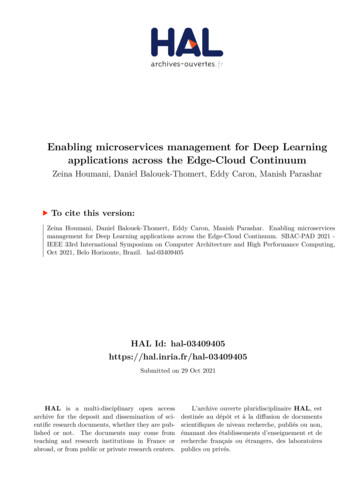
Transcription
Enabling microservices management for Deep Learningapplications across the Edge-Cloud ContinuumZeina Houmani, Daniel Balouek-Thomert, Eddy Caron, Manish ParasharTo cite this version:Zeina Houmani, Daniel Balouek-Thomert, Eddy Caron, Manish Parashar. Enabling microservicesmanagement for Deep Learning applications across the Edge-Cloud Continuum. SBAC-PAD 2021 IEEE 33rd International Symposium on Computer Architecture and High Performance Computing,Oct 2021, Belo Horizonte, Brazil. hal-03409405 HAL Id: tted on 29 Oct 2021HAL is a multi-disciplinary open accessarchive for the deposit and dissemination of scientific research documents, whether they are published or not. The documents may come fromteaching and research institutions in France orabroad, or from public or private research centers.L’archive ouverte pluridisciplinaire HAL, estdestinée au dépôt et à la diffusion de documentsscientifiques de niveau recherche, publiés ou non,émanant des établissements d’enseignement et derecherche français ou étrangers, des laboratoirespublics ou privés.
Enabling microservices management for Deep Learning applications across theEdge-Cloud Continuum InriaZeina Houmani , Daniel Balouek-Thomert ‡ , Eddy Caron , Manish Parashar‡Avalon team, LIP Laboratory, UMR CNRS - ENS de Lyon, University of Lyon, France‡ Scientific Computing Imaging (SCI) Institute, University of Utah, UT, USACorresponding author: zeina.houmani@ens-lyon.frAbstract—Deep Learning has shifted the focus of traditional batch workflows to data-driven feature engineering onstreaming data. In particular, the execution of Deep Learningworkflows presents expectations of near-real-time results withuser-defined acceptable accuracy. Meeting the objectives ofsuch applications across heterogeneous resources located atthe edge of the network, the core, and in-between requiresmanaging trade-offs between the accuracy and the urgency ofthe results. However, current data analysis rarely manages theentire Deep Learning pipeline along the data path, makingit complex for developers to implement strategies in realworld deployments. Driven by an object detection use case, thispaper presents an architecture for time-critical Deep Learningworkflows by providing a data-driven scheduling approachto distribute the pipeline across Edge to Cloud resources.Furthermore, it adopts a data management strategy that reduces the resolution of incoming data when potential trade-offoptimizations are available. We illustrate the system’s viabilitythrough a performance evaluation of the object detection usecase on the Grid’5000 testbed. We demonstrate that in amulti-user scenario, with a standard frame rate of 25 framesper second, the system speed-up data analysis up to 54.4%compared to a Cloud-only-based scenario with an analysisaccuracy higher than a fixed threshold.Keywords-Cloud computing, Edge computing, Microservices,Task allocation, Real-time processing, Computing Continuum,Deep Learning.I. I NTRODUCTIONDeep Learning has gained huge momentum in the industryover recent years with a growing market estimated at 44.3Billion USD by 20271 . Deep Learning (DL) applicationspresent a growing potential to extract knowledge from theanalysis of streaming data, with applications in numerousdomains including computer vision [1], speech recognition [2], and COVID-19 research [3].Deep Learning applications, implemented as distributedanalytics, are currently limited by Cloud-centric models thatsuffer crippling latency limitations when the amount andfrequency of data increases. The computational ecosystemthat supports these analytics has become highly heterogeneous and geographically distributed, bringing significantchallenges associated with the complexity and sustainability1 Global deep learning industry (2020), -Learning-Industry.htmlof performing decision-making on sensor data [4], [5]. Inparticular, many Deep Learning applications require important decision-making to be delivered in a timely manner [6],requiring a novel design that enables trade-offs between thetime and the quality of analysis.Meeting the application’s objectives when dealing withmultiple data sources and resources of heterogeneous capabilities highlights the need for resource and data management solutions. Resource management aims at task allocation strategies and collaborative infrastructure designs [7],[8], while data management approaches often consist ofcustomizing Deep Learning models to suit the resourceconstrained systems while addressing the trade-off betweenQoS metrics [9], [10]. Existing work tends to approach thesetwo aspects independently and rarely manages the entireDeep Learning pipeline, resulting in inefficiencies betweenthe design and the deployment of data-driven applications.Driven by an object detection use case, this paper presentsa system for time-sensitive DL workflows. The architecturerelies on heterogeneous resources close to data sources, inthe core and along the data path. This continuum allowsextracting insights from data at early stages, which helps inmanaging data-driven applications. By combining resourceand data management solutions, the system aims at managing trade-offs between analysis makespan and accuracyof results to meet application performance. Furthermore, itoffers means to developers to automatically distribute DeepLearning workflows across the Edge-to-Cloud continuum.This paper makes the following contributions: A data management strategy based on data qualityadaptation. It adjusts the resolution of data sources tomanage latency-accuracy trade-offs. A data-driven workflow scheduling approach to distribute DL tasks on the computing continuum.The rest of the paper is organized as follows. Section IIpresents the use case driving this work. Section III brieflydiscusses the related work. Section IV shows the systemarchitecture, performance models, and system utility function. The data adaptation approach is proposed in Section V.Section VI presents the strategies for distributing DL taskson the continuum. Section VII describes the experimentalsetup and results. Finally, Section VIII concludes this work.
II. M OTIVATING USE CASEFor data scientists, the data analysis process consists ofthree main stages. Pre-processing stage: It is responsible forpreparing incoming data for analysis. Additionally, this stageallows the characterization of incoming data. The extractedcharacteristics, such as data resolution, format, and size,contribute to a better selection of the analysis pipeline.Analysis stage: It corresponds to a set of Deep Learningmodels responsible for extracting features, detecting andrecognizing objects in the incoming prepared data. Thesemodels can be of different types, such as You Only LookOnce (YOLO) [11] and Faster Region-based ConvolutionalNeural Networks (Faster RCNN) [12]. These real-time detectors are based on convolutional networks that predictobject boundaries and object scores at each detection. Postprocessing stage: It processes the knowledge extracted fromthe previous stage. It can evaluate the resulting knowledgeand make decisions whether to ignore it, visualize it, storeit or urgently notify the end users about it.Current data analysis systems only consider Deep Learning applications as a set of learning models making theuse of management strategies complex in real-world deployments. Managing trade-offs for the entire pipeline on currentheterogeneous infrastructures is challenging: À tasks in eachstage demand different computing requirements. Assigningresources to these tasks must consider their roles in theanalysis. Á Deep Learning application deals concurrentlywith a high load of different resolutions. Assigning pipelinesto data sources has an impact on the system performance aseach data quality demands different computing needs.This work is driven by an object detection use case (Figure 1). It represents a time-sensitive Deep Learning application that identifies and locates objects in an image orvideo (sequence of images). First, Resize service receivesincoming frames and modifies their sizes to suit the inputdata size of the following task. This service belongs to preprocessing stage. Object detection task receives these framesand detects existing objects using two possible YOLOv4models: YOLOv4-416 for 416p frames and YOLOv4-512for 512p frames. These models are a part of the analysisstage. Finally, the frames and analysis results are sent toa Draw service responsible for marking the detected andidentified objects on the frames and save them locally. Thistask belongs to the post-processing stage.The execution of time-sensitive applications presents -processing stageAnalysis stageobjects,labels &framesDrawPost-processing stageFigure 1: Workflow of an object detection Deep Learningapplication showing the stages, dataflow, and tasks.pectations of near-real-time latency with user-defined acceptable accuracy. In this use case, the analysis accuracy corresponds to the number of detected faces and labels assigned.Meeting these objectives motivates the need for a systemsupporting DL pipelines with data and resource managementsolutions. It relies on the microservices paradigm to deploythe pipeline on the distributed resources. This paradigmprovides the capacity to monitor each task individually todetect events and maintain system performance. In this work,the terms tasks and microservices are used interchangeably.The proposed system is presented in Section IV.III. R ELATED WORKA. Edge-enhanced Data Analytic SystemsCloud-centric systems suffer crippling latency limitationswhen the amount and frequency of data increase [13].Therefore, Edge computing [14] has widely emerged tocomplement and extend the Cloud [15]. Model optimizationand Machine Learning inference are currently the mainvectors driving the use of resources at the edge [16]. Manyworks attempted to adopt Edge-based infrastructure designsto optimize analytics systems, where some systems focuson reducing energy consumption [17], guaranteeing deadlines [18] and meeting real-time requirements [19]. In [19],Kong et al. ensure a real-time analysis in consideration ofaccuracy by adopting an Edge-based system. However, thesystem only considers the inference time of Deep Learningmodels and not the entire analysis pipeline. In addition, dueto limited resources, the proposed system will fall short indealing with several high-resolution video streams.Cloudlet resources are widely used in Edge Computing. They are characterized by a high bandwidth networkrelative to the Edge and offer lower latency than theCloud [14]. Gigasight [8] reduces latency and bandwidthfrom Edge/Cloudlet to Cloud by running analysis on theCloudlet resources and sending only the results to the Cloud.In [18], Zamani et al. adopt a federated resources model thatexposes in-transit and edge capabilities to participant sites.The Microservices paradigm has gained great popularityin recent years, exploring the benefits of modular, selfcontained components for highly dynamic applications [20].This paradigm serves large-scale data analytics systems.In [21], Khoonsari et al. showed that microservices allow forefficient horizontal scaling of analyzes on multiple computational nodes, enabling the processing of large datasets. Inaddition, Taneja et al. adopted microservices in [22] due tomultiple reasons such as their deployability on hybrid FogCloud environments and their technological independence.B. Scheduling Strategies For Deep LearningScheduling approaches for Deep Learning can be classified into three main categories. First, job scheduling techniques are designed to schedule prediction and training jobson the Deep Learning cluster workers [23]. Second, single
task scheduling techniques for Deep Learning models witha guarantee of specific performance targets [24]. Lastly,workflow scheduling techniques are designed to distributethe entire application on the available resources [13]. Thiscategory is not yet well discussed in the literature for DeepLearning applications. The contribution of this work belongsto the last category.The functional partitioning of Deep Learning workflowand its distribution across Edge-Cloud resources has beenconsidered in [13]. The proposed scheduling approach isgoal-driven; the scheduling decisions made are motivatedby the system’s goal of satisfying the real-time requirements.These approaches do not consider the difference in the computing and network requirements of Deep Learning tasks,nor the dynamic impact of incoming data on the applicationperformance. The data-driven scheduling approach proposedin this work examines task heterogeneity and makes allocation based on the tasks’ categories and their dependencies.C. Configuration Adaptation For Edge-based SystemsAnalyzing concurrently multiple data streams with limitedresources forces resource-quality trade-offs [25]–[27]. As theincoming data are processed concurrently, resources available to each data stream are often unknown. Online/offlineconfigurations adaptation is currently a promising solutionto address the issue of limited resources [9], [26], [28]–[30].In [28], Wang et al. adopt an offline configuration adaptation and bandwidth allocation strategies to address the issueof limited resources between IoT devices and edge nodes.Similar to the approach presented in this work, the adaptation is triggered periodically. Systems in [9], [29] adoptan online configuration adaptation algorithms for videoanalytics in Edge computing. The configurations targetedare frame rate and resolution. However, these systems onlyfocus on the performance of the analysis stage and not ona complete workflow. Additionally, they only target Edgebased video analytics applications. In [30], they present anEdge Network Orchestrator for Mobile Augmented Reality(MAR) systems. It boosts the performance of an Edge-basedMAR system by optimizing the edge server assignmentand video frame resolution selection for MAR users. Inthis work, we argue that adopting a data quality adaptationstrategy for Microservice-based Deep Learning applicationsbuilt on a 3-tiers environment will optimize the analysislatency with respect to accuracy constraints.IV. M ODEL AND A RCHITECTUREA global system overview is presented in Figure 2. Thesystem’s architecture consists of three levels. Each hasa set of management services following the microserviceparadigm and communicates via APIs.Workflow management level. It is responsible for categorizing and scheduling the submitted pipeline (P ) acrossthe resources (see Section VI). The pipeline is composedof three stages: Pre-processing (P r), Analysis (A) andPost-processing (P o) stage. Each stage s is composed ofa set of microservices M {mi }. The analysis stagehas Z learning models. These models can be of differenttypes (Faster RCNN, YOLO, etc.) or the same type butsupport different input quality (YOLO416, YOLO512, etc.).Let D {d1, d2, ., dZ} represent the set of modelsand Q {q1, q2, ., qL} the set of data quality supported.Infrastructure level. Its design is based on the Edge-toCloud computing continuum. The set of resources is givenby R {rk } which represents the set of Edge (E), Fog (F ),and Cloud (C) nodes. In this work, the terms Cloudletand Fog refer to the same type of resources. Cloudletresources provide computational capabilities greater thanEdge resources and less than Cloud resources. The capacityof the Cloudlet-Cloud network link is a thousand timeshigher than the capacity of the Edge-Cloudlet link. Thesystem supports multiple data sources located at the Edge,each generating data in the default frame rate (f s 25f ps)and resolution (f r 512 512). The set of data sourcesin the system are denoted by U {u1 , u2 , ., uk }. A framegenerated by a data source is considered as a job J to beprocessed by the application. Let N be the total number ofjobs generated by a data source in a time slot t.Data management level. It selects the data quality distribution for data sources providing a system makespan andaccuracy that meet the developer’s needs. This level consistsof three components. First, a discovery component responsible for the pipeline discovery. Second, performance modelsthat estimate the makespan and accuracy of the assignedpipeline. Third, a data quality adaptation component thatselects for data sources the qualities providing the bestestimated performance.The remainder of this section presents the analyticalmodels of the end-to-end latency and accuracy of K datasources, as well as the formulation of the system’s objective.A. End-to-end Latency ModelThe end-to-end latency of a job J from a data source ucorresponds to the time taken to complete its analysispipeline. It is presented as follows:TJu µ · Treduce TP r TA TP o(1)Treduce refers to the time required to reduce the job’s qualitybefore the processing starts. µ is a binary that indicateswhether a data adaptation was needed for u or not. Detailsabout data adaptation will be presented in Section V. TP r ,TA , and TP o correspond to the time spent in the preprocessing, analysis, and postprocessing stages, respectively.Total time cost (Ts ) of a processing stage is the sumof the responsePn time of its microservices. It is presentedas Ts i 1 RT (mi ) where RT (mi ) α · TD T rans(mj , mi ) TE . RT (mi ) represents the response timeof microservice mi . α is a binary variable that indicates
Workflow managementTask schedulingTask categorizationSubmitDeep Learning workflowPre-processingSchedule workflowTaskTaskInfrastructure resourcesTaskTaskAnalysisData sourcesE:1CamerasTaskTaskC:1E:NEdge TierSensorsC:NCloudlet TierCloudPost-processingCloud TierStream data todeployed workflowData managementPerformance estimationDataDatabasesService discoveryData quality adaptationFigure 2: Global overview of the system design. It consists of workflow management, infrastructure, and data managementlevel.whether a microservice discovery happened or not whileprocessing a job. TD represents the discovery time of themicroservice. T rans(mj , mi ) represents the time neededto transfer the data input of microservice mi from itspredecessor mj . Let rj and ri be the resources where mj andmi are deployed respectively. For clarity, T rans(mj , mi ) isreplaced by T rans(rj , ri ). TE corresponds to the executiontime of the microservice.The transfer time of the data is formulated as: SS w(rj , F ) w(F, ri )T rans(rj , ri ) 0 S w(rj , ri )if rj E, ri Cif ri rjotherwise,(2)S refers to the data size (in Mbits) to be sent over thenetwork. It is given by S γf r2 . γ is the number of bitsrequired to represent the information carried by one pixel.w(producer, consumer) refers to the bandwidth (Mbits/s)of the network link between the data producer and consumer.If they were deployed on resources {ri , rj } {E, C}, thetransferred data must pass through the Cloudlet tier.The execution time of a microservice is presented asTE Load/C where Load refers to the data to beanalyzed by mi and C to the number of data that can beprocessed per second. In stage A of the pipeline, the throughput depends on the chosen Deep Learning models and theincoming data quality of the data source. As experimentallyproved in [28] and [29], with high data quality, the modelsprovide a slower analysis speed than that with low quality.In addition, it [31] showed that with the same data, somemodels perform faster than others.Thus, the average end-to-end latency of K data sources ina time slot t is presented as follows: KN1 X 1 X i TTt K i 1 N j 1 j(3)B. Analysis Accuracy ModelAnalysis accuracy of DL models corresponds to the metricF1 score. It is a weighted average of the Precision and Recallevaluation metrics. To identify their True Positives (TP)and False Positives (FP), the Intersection over Union (IoU)metric is used. IoU is a number from 0 to 1 that specifies theamount of overlap between the predicted and ground truth(i.e., actual) bounding box. If IoU 0.5 and the label iscorrect, the analysis is TP. However, the analysis is FP ifthe label was false or the IoU 0.5 and the label is true.It has been experimentally observed in [28], [29], [31]that the data quality and the chosen DL model impactthe accuracy of the results. As showed in [28], [29], therelationship between accuracy and data quality is formulatedas a concave exponential function of three coefficientsE(f r, d) α1d α2d e f r/α3d . It reflects that a higherquality produces a better analytics accuracy, and the analytics accuracy gain decreases at a high quality. In this work,{α1, α2, α3} are constant coefficients of a DL model d.Due to the data-driven discovery mechanism, changingthe data quality by the data management strategy during atime slot will cause a change in the selected Deep Learningmodel. Let φiJ and βJx be two binary variables that indicatewhether model di and data quality qx are selectedfor dataPZysource uk to process its job J. So, d0kφJ y 1 J,k dy isthe DeepLearningmodelofjobJfromdatasourceuk andPLPZxqJ0k x 1 βJ,kqx is its data quality with y 1 φyJ,k 1PLxandx 1 βJ,k 1. Hence, the average accuracy of aPNdata source uk in time slot t is N1 j 1 E(qj0k , d0kj ). During
PZPLyxa time slot,y 1 φk andx 1 βk can be greater than1, which indicates that a data source can use multipleDeep Learning models and have multiple data qualities.The average accuracy of K data sources in a time slot tis presented as follows: KN1 X 1 X E(qj0i , d0i(4)at j)K i 1 N j 1C. System ObjectiveThis work aims to reduce the data analysis latency of DeepLearning applications under a long-term accuracy constraint.To achieve this objective, a latency-accuracy trade-off utilityfunction is needed. It is formulated as Uu,t au,t ΘTu,twhere Θ trades off between the latency cost and accuracy.The total utility for K data sources is presented as:Ut K1 XUi,tK i 1(5)Maximizing this utility during runtime, with respect tothe accuracy constraint, will increase the system efficiency.As in [28], the long-term utility augmentation will becomelimited. So, the system goal is formulated as follows:Goal :maxβ,φT1X(Ut )t Tt 1limT1Xsubject to limat amint Tt 1(6)The accuracy constraint ensures that the tradeoff is onlypossible if the long-term average accuracy exceeds theminimum threshold amin (by default, amin 50%).The system aims to adapt the quality of incoming data tooptimize this utility (see Section V).V. DATA Q UALITY A DAPTATION S TRATEGYThe system contains a set of distributed and limitedresources of different computing and network capacity.Analyzing data generated by multiple data sources onthese resources requires adopting a latency-accuracy tradeoffsolution. This section presents a data quality adaptationstrategy for DL applications. This strategy is responsible forspecifying the distribution of data qualities on the existingdata sources. It estimates whether the system can handle theoriginal data qualities of all data sources or a quality reduction is required. Reducing data quality can negatively affectthe analysis accuracy. So, this strategy controls the quality ofgenerated data while guaranteeing a system accuracy higherthan a fixed threshold amin . The microservices responsiblefor applying this strategy are deployed on the Edge.Deep Learning applications have dynamic data content.Therefore, adapting data quality once during analysis isinefficient as the performance varies depending on thecontent. For that reason, the adaptation strategy is triggeredperiodically and when new data sources join the system.Let B {b1 , ., bm } be the set of possible qualitydistributions among data sources. Each distribution bi isformulated as {β · ql 1 β k and ql Q}, where βrepresents the number of data sources having the data qualityql and k is the total number of data sources in the system. qlmight corresponds to their original or reduced data qualities.In the object detection use case Q {512p, 416p}. Forn 3, a possible data quality distribution can be b1 {(2) ·Q512p , (1) · Q416p }.The proposed strategy selects from B the distribution withthe fastest analysis latency and accuracy that does not fallbelow the amin threshold. However, in specific use cases,the selected data quality distribution may not be the fastest:The system compromises between latency and accuracy incase there is another distribution that provides a latencygain less than 10ms but an accuracy loss greater than orequal to 20%. The strategy is presented in Algorithm 1. InAlgorithm 1: Select the quality distribution with a latencyaccuracy trade-off.Result: quality distribution with the optimal trade-off.begin1initialization;2for b in B do3L getEstimatedLatency(b) ; // model (3) in IV-B4A getEstimatedAccuracy(b) ;// model (4)in IV-B5678if A amin thenadd({b, L, A}, list);if isEmpty(list) TRUE thenreturn 12best getMinLatency(list);for x in list doif 4(x[L], best[L]) 10 and4(x[A], best[A]) 20% thenbest x;13return(best);91011steps 2-6, it calculates the estimated latency and accuracyof each possible data quality distribution. Then, in step 5, itfilters those with unacceptable accuracy. If no configurationprovides acceptable accuracy, the data source can’t join thesystem at that time period (steps 7 & 8). Otherwise, the preferred data distribution among the acceptable configurationsis the one with the fastest analysis (step 9). In steps 10-12,it checks if there is another distribution that matches theuse case presented above. If so, it will be selected as thepreferred quality distribution in the system.After selecting the data quality distribution, the systemrandomly maps qualities to data sources. This mappingswitches periodically between data sources.
VI. DATA - DRIVEN WORKFLOW SCHEDULING ANDDISCOVERY APPROACHESSeveral challenges exist when scheduling the Deep Learning pipeline on the continuum: À tasks in the pipelineare heterogeneous and have different resource requirements;Á the system has limited resources; Â system resourceshave different computing and network capacity; Ã in a continuum, resources can become unavailable. For challengesÀ and Â, this work adopts a scheduling approach basedon a task categorization. Its purpose is to distribute DeepLearning workflow across the edge of the network, the core,and along the data path with regards to the microservices’functionalities and data inputs. For challenge Á, the systemadopts a requirement adjustment algorithm to efficientlyusing the limited resources. The 4th scheduling challengeis beyond the scope of this paper. Each component in thescheduling approach is deployed as microservice and locatedon the Edge tier. The scheduling approach is triggered whena new workflow is submitted. When triggered, the categorization microservice receives the workflow description.After examining each task, It sends the description with thecategorization results to the reservation microservice. Thelatter allocates the resources and triggers the schedulingmicroservice. If the available resources are not enough, ittriggers the adjustment microservice.Assigning a data source to a scheduled pipeline matchingthe resolution of generated data is done via a data-drivenmicroservice discovery mechanism running on the Edge.A. Tasks CategorizationTasks in Deep Learning pipelines demand different CPU,memory, storage, and bandwidth requirements. Based on ourobservations in deploying and running DL applications, taskscan be classified into three categories: Non-Intensive (NI),Low-Intensive (LI), and High-Intensive (HI) tasks.NI tasks refer to the pre-processing and post-processingtasks that do not manage their own database. Databasemicroservices are considered HI due to their storage demand. In our application use case, Resize microserviceis considered NI and Draw microservice as HI. Classiclearning models (i.e., shallow models) are LI. ConcerningDeep Learning models, their characteristics have an impact on their performance, such as the number and typeof parameters and neural network layers. In this work,we only consider the data resolution to categorize DeepLearning models. For each learning model in the analysisstage (YOLO, Faster RCNN, etc.), the implementation withthe lowest resolution is considered LI. For example, in theobject detection use case, YOLOv4-416 is considered as LIand YOLOv4-512 as HI.In practice, users need to specify in the description of thesubmitted workflow the type of each task (pre-processing,shallow, etc.). The system will then automatically assigneach type to a category, as mentioned above.B. Resource Reservation And Scheduling AlgorithmsA naive approach for assigning tasks to resources is toexplore all the possibilities in a brute-force manner whichcreates a search space of exponential complexity. This workadopts the following pruning techniques to minimize thesearch space. First, all tasks within the same category havethe same resource assignment. Second, intensive tasks canonly be deployed on the Fog and Cloud. HI tasks have apriority to be assigned to the Cloud and LI to the Fog.The scheduling approach consists of two parts. The firstpart aims to reserve resources for intensive tasks. It givesHI tasks a higher placement priority than LI tasks. Theresource reservation for HI tasks is presented in Algorithm 2.This algorithm takes as input the number of HI tasks inthe submitted workflow. In step 1 and 2, it retrieves theavailable resources in Cloud and Cloudlet tiers, respectively.In step 3, it counts the number of HI tasks that can be placedon the Cloud. This depends on the capacity of the Cloudtier and the fixed requirements of the HI tasks. Steps 4-16check whether the computing requirements of HI tasks canbe fully guaranteed at the Cloud or they must be distributedacross Cloudlet-Cloud tiers.
The Microservices paradigm has gained great popularity in recent years, exploring the benefits of modular, self-contained components for highly dynamic applications [20]. This paradigm serves large-scale data analytics systems. In [21], Khoonsari et al. showed that microservices allow fo
